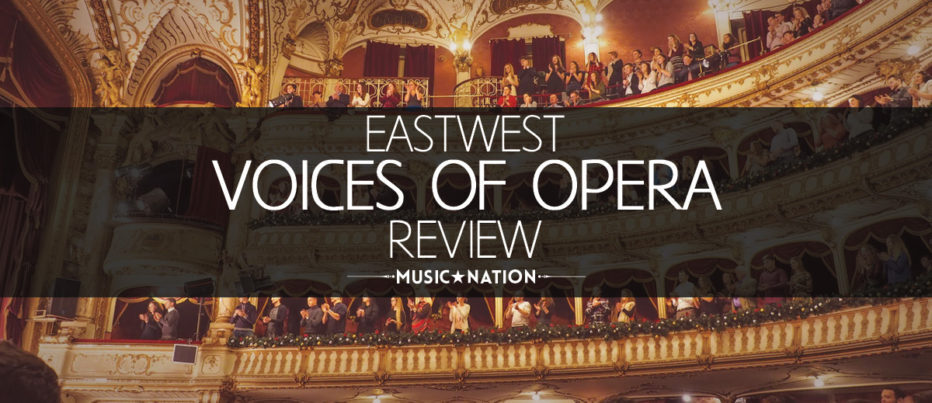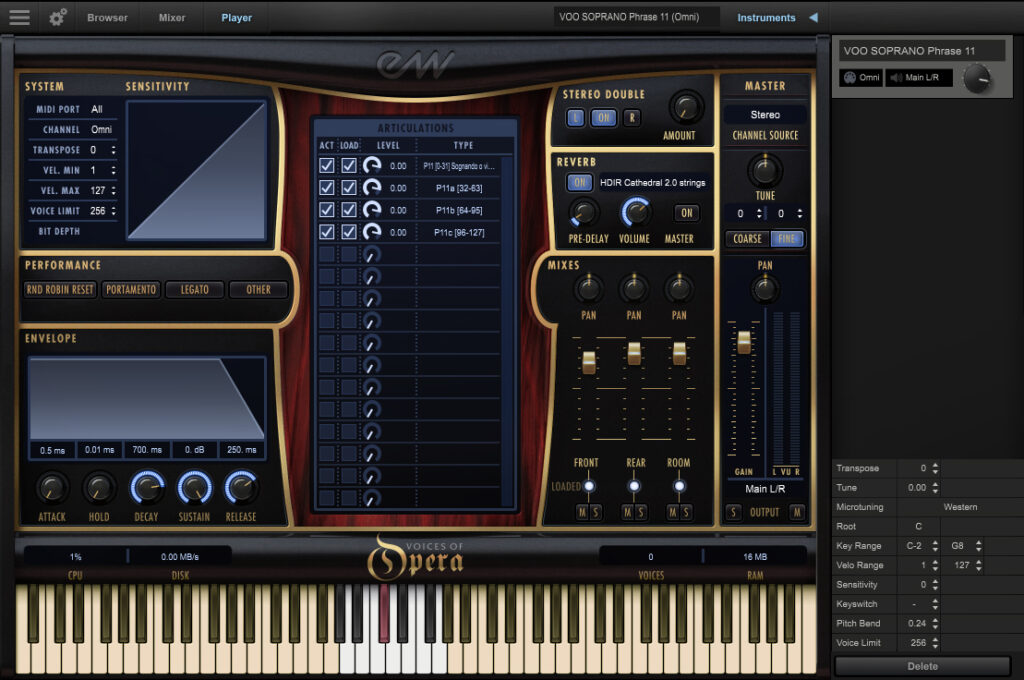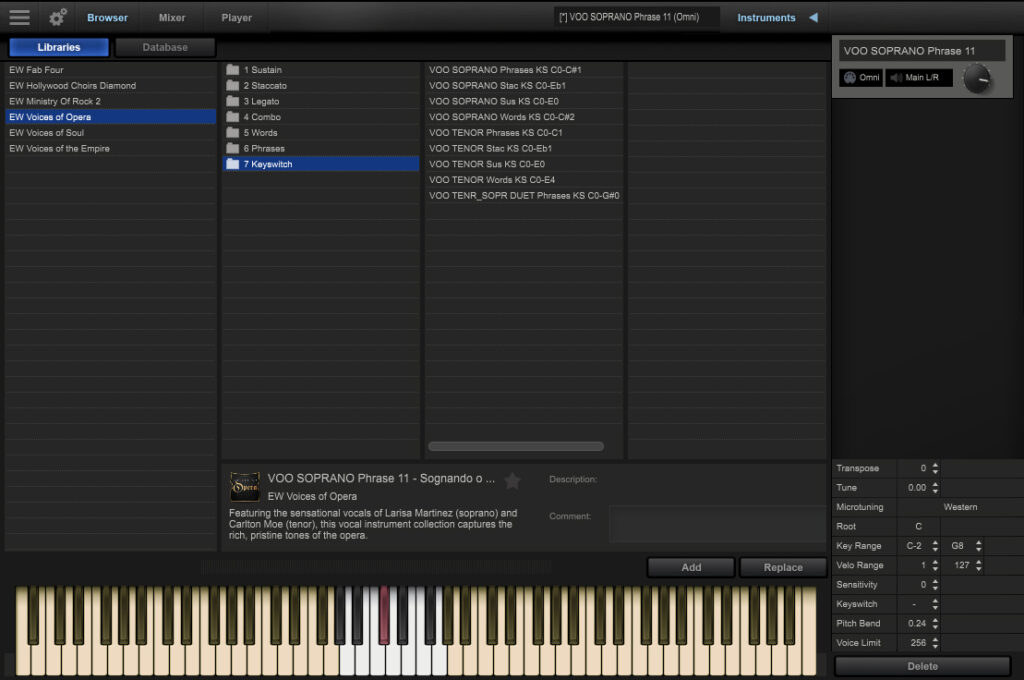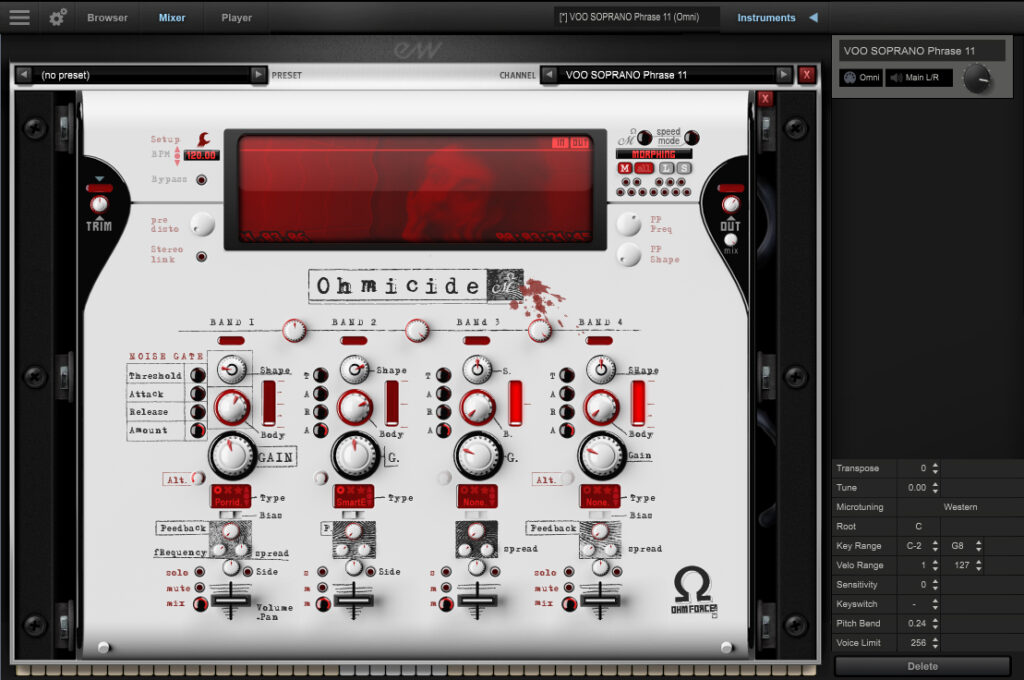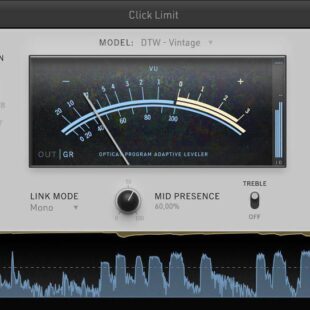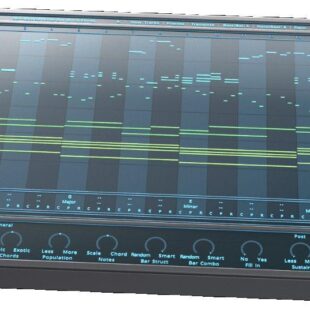EASTWEST VOICES OF OPERA – BRAVE NEW HORIZONS
Replicating convincing-sounding orchestral strings, synths or percussion is one thing, imitating the human voice is quite another. Designing a sample library that allows users to play their own personal opera singer was in the realm of fantasy back when I first got into digital audio.
I’m sure the challenges of creating a believable operatic performance would be insurmountable for anyone without the experience and resources available at EastWest.
Having established themselves as leading producers of software in the genre, EastWest’s recent Voices of Soul was a brilliant offering, so I was very much looking forward to seeing what they would achieve with their latest opera-themed expansion.
Overview
Voices of Opera is a male and female vocal sample library for EastWest’s proprietary Play engine. Featuring the vocal talents of tenor Carlton Moe and soprano Larisa Martinez, the library was recorded at EastWest’s incredible Hollywood studio on Sunset Boulevard, and produced by Doug Rogers and Nick Phoenix.
The 40GB library contains over 20,000 samples recorded with the best recording equipment available. In total, the library contains 229 “instruments”, or patches covering multiple vocal styles, phrases, words and sung snippets from famous arias.
Voices of Opera is a continuation of their ‘Voices’ series which includes Voices of Soul, Voices of the Empire and the full-ensemble collection, Hollywood Choirs.
As with all EastWest products, you can purchase the individual libraries outright or subscribe to the ComposerCloud and receive the entire 40,000+ instrument catalogue from $19.95USD per month.
All EastWest products are installed via the EW Installation Manager which allows you to add or remove elements as needed (or as hard drive space allows). All elements are interconnected via a built-in database system so you can easily search for sounds directly inside the plugin.
The EW Installation Center software is required to manage your collection of libraries and effects, and though it requires an update every time you open it, the slick interface performs beautifully, downloading your titles to the correct directory, taking care of all the tiresome iLok rigmarole and activation duties.
Weighing in at over 45GB, this is a hefty library, but it downloaded extremely quickly and I was up and running in under 30 minutes.
Play Engine
Like many sample libraries these days a core software plugin must be loaded first to contain your expansion titles.
EastWest’s ‘Play’ Engine is unique over others in that it presents a full, in-the-box mixing environment leaving individual expansions to provide very basic synthesis, usually ADSR and cut-off/resonance filters.
The advanced mixing, bussing and routing provide plenty of scope for creative layering of instances, which is possibly a little overkill for a title like Voices of Opera, but all the same, it is very handy most of the time with instrument libraries. I always feel it is a shame that the sweet effects section is locked away inside Play, meaning you cannot access the processing for other tracks in your DAW.
Play Engine’s design is very elegant, but the workflow is clunky because it handles all of the browsing database systems and mixing under separated tabs, meaning you need to swap back and forwards to change patches.
EastWest expansion libraries all appear to have the same allocated amount of real estate, meaning the vast majority of the UI is filled with mostly unimportant fluff, images and faders mirroring the mixing desk. Incorporating the patch browser on the front end would vastly improve the workflow.
The patch database, in theory, is awesome, allowing you to use metatags to search through the entire back catalogue of EastWest libraries to find specific sounds. Subscribers to the ComposerCloud will love the flexibility here, but a quick snippet preview would make this more streamlined as currently there is only a somewhat hieroglyphic code description for each patch, making the entire process very much click-and-hope for the best.
Play Through
The patch structure for Voices of Opera is rather confusing and I was lost with the number of choices available. Ultimately, there are only two main categories of patches to consider; Legato or articulations (key switches) – all the rest are individual elements broken down into their own patches. Articulation patches are separated into key switch groups or combos.
Firstly, the legato section. These patches play only single notes with a scripted glide allowing you to play notes over one another to create a realistic transition between notes. Legato is the place to start if you’re looking for a soloist-type sound.
The scripting requires quite a rigid playstyle to obtain the most realistic results. So you can’t just bang notes out on your keyboard and expect perfect performances. Each note requires a decent amount of time to evolve before playing the next so it can have a cleaner transition. On top of that the velocity at which you strike the keys changes the timbre of the voice as well, which makes another element to consider.
It takes some time to become familiar with the legato feel, so expect a decent period of rehearsal until you’ve mastered the knack. You will probably need to tweak the attack and release controls to match your playing style and to help lines flow seamlessly.
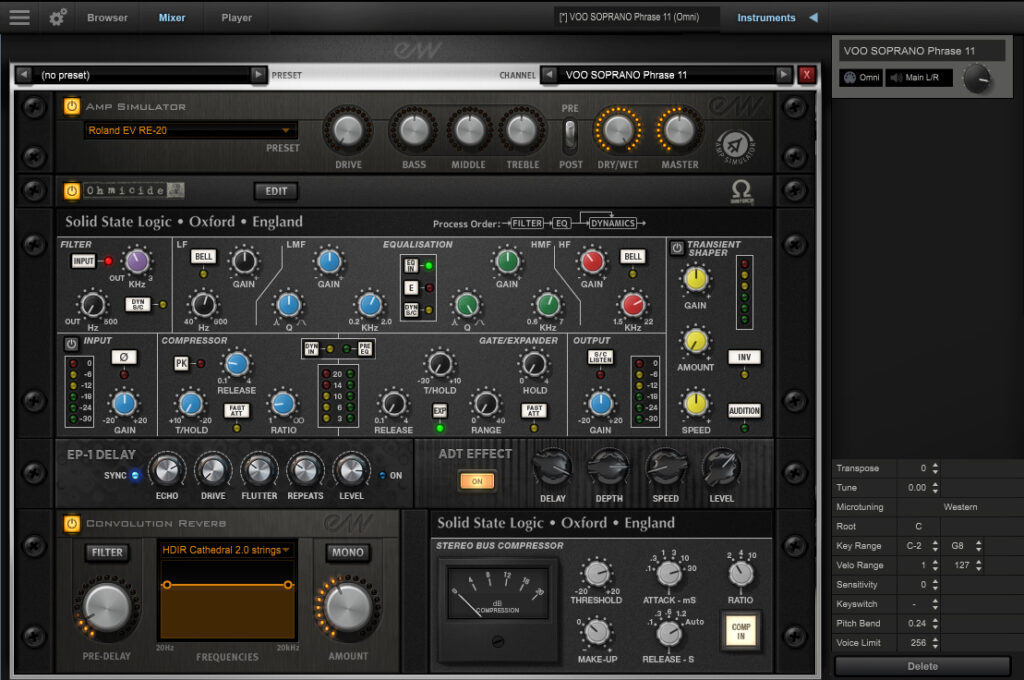
The legato category only contains ‘Ah’ and ‘Oh’ for both tenor and soprano, plus a mod wheel alternative for each. I prefer the ‘Mod’ versions as it allows you to set the velocity of the sample before you strike the note with your controller’s mod wheel, offering greater control. It would be good if there was a way to see your mod wheel positioning, as it is mostly guesswork.
The other main category is articulation-type patches of which there are two main sub-categories; combos and key switches. In essence, they do the same thing, the difference lies in how your controller interacts with the patches.
Combos feature legato, staccato and sustain performances from both tenor and soprano. The sustain and legato patches are mod wheel-controlled, and staccato is velocity controlled.
Don’t ask me why they are all in the same directory, I did say this was confusing!
Combos without mod wheel control cycle through eight unique samples round-robin style, with the velocity based on the power you strike your keyboard. So each time you strike a key a new sample is played, one after another until you’ve covered all eight, and then it loops back to the beginning again. It’s a bit wacky and I’m not sure if you would ever want to use this. However, it is there as an option if you’re after something really random sounding, I guess.
The alternative sustain and legato combos that have mod wheel control, in essence, do the same thing but you control the articulation choice with the mod wheel, which makes more sense. You can play a particular sample as many times as you like, changing to the next when you are ready by moving the mod wheel to the appropriate position.
It takes a little practice as there is no indication of where you are with your mod wheel, but it’s by far the most intuitive way to key-switch articulations.
At first, performances might sound a little disjointed, but it did not take me long to judge the timing and velocity to start making some rather nice-sounding passes. The tenor voice is slightly more forgiving due to the lower register, the higher soprano quickly starts to sound fake if you are not right on point with your performance.
All combo articulations are played as one-shots, which is a bit of a shame. This means you can’t play a sample and morph through different vowels using the mod wheel or MIDI automation.
And finally, the key switch category contains all of the same patches but this time they are triggered by key strikes. This means all of the sample articulations are laid out over your keyboard and you simply trigger the one you want. You do lose a lot of your keyboard real estate to these trigger zones, but this is a more traditionally accepted way to operate sample libraries, especially for Kontakt users.
Everything else in the browser is simply replications of the main patches, separated out into individual presets (Sustain, staccato, words and phrases).
The Sound
Firstly, right off the cuff – the sound quality is absolutely amazing. Both tenor and soprano performances have been recorded incredibly well and the level of continuity between takes is outstanding.
It must be extremely difficult consistently to sing operatic notes at this level over weeks, and the two performers deserve a standing ovation.
The included microphone options are excellent, but not overly flexible. The main close mic produces the bulk of the sound, with the rear and room mics providing slight ambience support, but nothing too radical.
The sound is quite tight, as you would hope. There isn’t a large ambience so I guess that the parts were recorded in a vocal booth. The provided convolution reverb will be your main environmental effect.
The tuning of both tenor and soprano parts is impeccable – trust me – I tested this thoroughly. The only slight quirk I encountered is that the timing between the two singers can be slightly off. Often the male is slower to develop his vowels so he finishes his phrase behind the female when played in tandem. While not game-breaking, on held chords it sounds as if the male is upstaging the female all the time.
The word patches sound great, but you need to ignore what the vocalist is singing unless you’re fluent in Latin. The seemingly randomly chosen words all sound very operatic, but how one is meant to arrange them into a legible sentence is beyond me.
This is an unusual library to get a grasp of out of the box. It took me quite a while to somewhat master the very light touch you need to make the phrases blend together. Even still, it is very difficult to achieve a fluid performance without using automation.
However, the very interesting thing about Voice of Opera is its surprising cohesiveness with other instrument libraries – particularly orchestral strings. It is easy to pick out shortcomings when it is played as a solo instrument – but when used in conjunction with other instruments (and a good lathering of reverb) the orchestral instruments fill the gaps and blur the rougher transitions well.
To be fair, I do not see this holding up as an unaccompanied soloist, but I do not believe that was the intent. As a background vocal texture or ambience effect, Voices of Opera sits in your arrangement mix extremely well and is very difficult to discern anything artificial.
I found some nice results pairing Voice of Opera with larger vocal libraries, such as EastWest’s Hollywood Choir and Spitfires Eric Whitacre Choir. If you’re looking for more of a small ensemble-type sound, the previous Voices of Soul works wonderfully as a duet to Voices of Opera.
I tested Voice of Opera with more generic vocal libraries, such as Kontakt’s Factory choir and Reason Studos’ excellent Humana instrument, but Voices of Opera is totally in a class of its own and outshines these lesser stablemates making them too jarring to use together.
Conclusion
This is another courageous title from EastWest who are proving they are confident to attempt quite audacious products. While you could argue the previous Voices of Soul was aimed at a perhaps less cultured ‘pop’ crowd, and thus had an easier run, I would agree the Opera contingent is a much more concerning bunch and will be more challenging to convince.
Voices of Opera is not a soloist replacement library – far from it. But as an ambient voice, small ensemble or slightly upfront tenor and soprano duet, the library does perform an admirable job.
Voices of Opera will not recite Nessum Dorma word for word, but ‘la’, ‘Oh’ and your other basic consonants and vowels are handled perfectly well.
The sound quality was never going to be in question with this title: this comes from EastWest after all, and they are the best in the business. The real test is the tactile feel and how difficult it is to pull off convincing opera performances from a MIDI controller.
At $199 introduction price this is good value, considering the recording quality and vocal performance level. The ComposerCloud subscription service is, however, a total game-changer for producers. For under $20 per month, you can access every product in the range, including all new releases and effects. A no-brainer, really.
Voices of Opera is a good example of a clever idea executed well. EastWest has not tried to push beyond the limits of the technology and has provided a solid foundation for producers to work with.
There is nothing else quite like Voices of Opera on the market nor another developer brave enough to attempt it. A solid addition to the ‘Voices’ range making this category an attractive drawcard for the brand.
Why not try ComposerCloud and take Voices of Opera for a spin yourself, visit EastWest for full details www.soundsonline.com

Like the review? Shout us a cup of coffee!
Title image courtesy of Vlah Dumitru @vlahdum1tru

